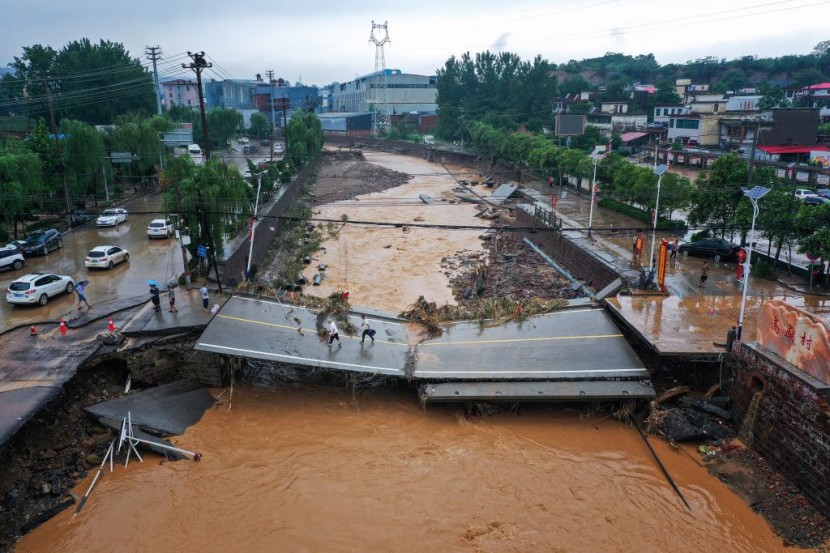
Floods that have killed people and disrupted lives in China and Germany are a harsh reminder that climate change is making weather increasingly intense throughout the world.
On Tuesday, at least 25 people died in the central Chinese province of Henan, including a dozen trapped in a city subway as floodwaters swept through Zhengzhou, the provincial capital, following days of heavy rain. Following the floods that killed at least 160 people in Germany and another 31 in Belgium this week, the catastrophe has reinforced the message that major adjustments are required to prepare for future occurrences.
Germany Floods: Hope of Finding Survivors Fades
The flood that killed 171 people in Germany might cost between $4.7 and $5.9 billion in the two German areas that were most hit. With hundreds of people killed or missing and billions of dollars in damage in Germany as a result of recent flash floods, one Catholic relief group says the situation on the ground resembles a warzone rather than a natural catastrophe.
According to Douglas Graf von Saurma-Jeltsch, head of Malteser International Europe, a charity organization managed by the Order of Malta, recent floods in western Germany is "like a bomb" that has detonated, according to Crux. Last week, a slow-moving weather system in western Germany dumped two months' worth of rain in two days, creating near-instant flash floods that trapped many people in their houses, automobiles, or other locations and caused devastating damage.
Authorities have verified at least 171 deaths so far, with 123 of them coming from the Rhineland-Palatinate district of Ahrweiler alone. A total of 764 individuals have been wounded, with another 155 still missing.
Approximately 40,000 people are thought to have been impacted by the floods in the Ahr valley and surrounding North-Rhine Westphalia areas, which have left thousands without access to drinking water, gas, and power.
As transportation routes have been damaged or destroyed and some 20 medical institutions in the area have closed as a result of the floods, there is rising worry about a lack of medical professionals and supplies in the impacted areas.
My best friend’s parents (I call them my German Mama and Papa) live in Solingen, NRW. They’re safe and dry, but sent me this video of the Wupper river. Thinking of those of you impacted by these horrible floods. #Germanyfloods pic.twitter.com/398gzERSHL
— Kelsey Farish (@KelseyFarish) July 15, 2021
Read Also: Nigeria Kidnapping Crisis: Nearly 100 Women, Children Freed After 42 Days of Captivity
China Flooding: The Horrific Event Expose Weak Infrastructures
Meanwhile, official media claimed that at least 33 people have been confirmed dead, with eight still missing, as a result of record-breaking floods in central China that have caused tens of thousands of people to flee their homes. As rain spread northwards from Zhengzhou, the hard-hit provincial capital, about 650 kilometers (400 miles) southwest of Beijing, the provincial weather bureau raised the storm alert to red for four cities in Henan's north - Xinxiang, Anyang, Hebi, and Jiaozuo - the highest tier of a four-step color-coded weather warning system.
Twelve people were killed when Zhengzhou's subterranean metro system was swamped, while others perished when an underpass was flooded. A total of eight persons have been reported missing across the province, as per Al Jazeera via MSN.
According to the official Xinhua news agency, more than 73,000 people have been evacuated from Anyang, on Henan's border with Hebei province, after the city was flooded by more than 600mm (24 inches) of rain since Monday. The deadly flooding of the Zhengzhou subway led local officials to issue a quick directive to enhance flood management and emergency response for urban transit.
Commuters on carriages that had been plunged into darkness were seen immersed in chest-deep water in a media video. One subway station was transformed into a huge lake of churning water.
This is currently the city of Zhengzhou in China. We are in a climate emergency. #ClimateActionNow #ClimateEmergency #China #Floods pic.twitter.com/7OdraXHcKK
— KevinMzalendo (@kenyakevo254) July 20, 2021
Climate Vulnerability with Floods in China, Germany
According to a study published, climate change in Europe is projected to increase the incidence of huge, slow-moving storms that may stay longer in one location and bring deluges like those experienced in Germany and Belgium. As the atmosphere warms due to climate change, it stores more moisture, resulting in more rain being discharged as rain clouds break. Experts said such storms might be 14 times more frequent by the end of the century, based on computer projections.
While the floods that destroyed wide portions of western and southern Germany were thousands of kilometers apart, both examples showed the susceptibility of densely populated areas to severe flooding and other natural catastrophes. It will cost billions to reinforce dikes and climate-proof houses, highways, and urban infrastructure.
However, horrific mobile images of individuals crawling through subways in Zhengzhou that were inundated in chest-deep water or sobbing in terror as mud and debris surged through ancient German villages demonstrated the cost of doing nothing. Both China and northern Europe experienced tragedies as a result of extremely high rain, comparable to a year's worth of rainfall in only three days in China, which completely overcame flood defenses.
Buffers had been built along major German rivers like the Rhine and the Elbe after many devastating floods in recent decades, but last week's heavy rains also converted lesser tributaries like the Ahr and the Swist into terrifying torrents. Scientists believe that built-up metropolitan areas with insufficient water evacuation and massive dams that altered the Yellow River basin's natural flow may have also contributed to the tragedy in China, Reuters through MSN reported.
However, efforts such as strengthening building resilience, elevating riverbanks, and improving drainage are unlikely to be sufficient in and of themselves to prevent catastrophic floods. As a last option, warning systems will need to be enhanced, which have been widely criticized in Germany for giving people little time to respond.
Related Article: China Flooding: Worst Rainfall in Decades Swamps Central China Province
@YouTube








